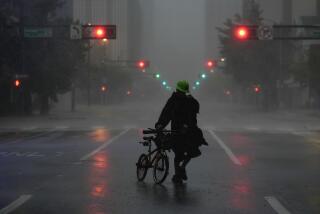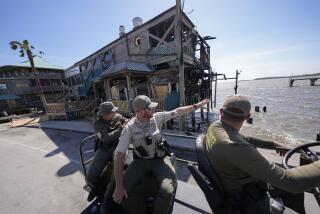SCIENCE FILE / An exploration of issues and trends affecting science, medicine and the environment
Tropical Storms
Hurricane Opal raked expensive beachfront homes along Florida’s Panhandle, packing maximum winds of 125 m.p.h. and swamping coastal communities with torrential rain and storm-surge tides as high as 15 feet. The storm went on to drench parts of the southeastern United States and the Ohio Valley with rainfall. Earlier, Opal destroyed crops and made tens of thousands homeless in western Cuba and Mexico’s Yucatan Peninsula.
Hurricane Roxanne headed for the Yucatan with steady 105-m.p.h. winds, menacing the same area where Opal roared ashore.
Hurricane Noel moved over the open waters of the mid-Atlantic.
Hong Kong cleaned up after typhoon Sybil, which caused damage and minor injuries before moving ashore over southern China.
Desperate Marauders
Drought in Zimbabwe has caused troops of hungry baboons to raid villages in search of food, according to the Zimbabwe Inter-Africa News Agency. The report said that the animals were abandoning the wild in some parts of the country to ransack villagers’ chicken pens and vegetable gardens. More than 40 baboons besieged a home in the Gokwe district where they killed 10 chickens and devoured dozens of eggs.
Renewed Rumblings
A string of small tremors beneath Mt. St. Helens volcano has prompted officials to close down hiking trails around the 8,364-foot mountain. The trails will remain off limits until it can be determined if new cracks have opened that may allow rain or snow melt to seep into the deeper hot zones. Such an event could cause unexpected steam explosions.
Authorities in New Zealand lowered the alert status around Mt. Ruapehu Volcano from Level 4 to Level 3 after three days of subdued activity. There is still a threat of mud flows on the slopes but no further danger to aircraft.
Polynesian Test
A powerful underground nuclear test at France’s Fangataufa Atoll test site in the South Pacific sparked another round of international outrage at the country’s renewed testing program. Seismologists estimate that the blast has a magnitude fo 5.5, and a force of about 100 kilotons.
Before the blast, the Tahitian environmental group Ia Ora Te Natura said that further testing at Fangataufa and Mururoa atolls could cause a slaughter of endangered species. The group described a feeding frenzy on the atolls as sharks were lured to the bodies of fish killed by previous nuclear test shock waves. “The innards of most of the fish killed had been expelled through their natural orifices, but sharks appear to be hardly affected by the tests,” the group said.
Earthquakes
Thousands of homeless people walked dazed through the streets of the small Turkish town of Dinar on Monday, or searched desperately through their wrecked homes, after a massive earthquake that claimed at least 89 lives.
A powerful temblor centered in the remote jungle area of southern Ecuador killed at least one person near the epicenter and knocked out telephone service as far away as Bogota, Colombia. In Japan, the thousands of small tremors that rumbled beneath the Izu Peninsula, just south of Tokyo, were said to be associated with increasing volcanic activity deep within the Earth. Earth movements were also felt in Japan’s northernmost Hokkaido Island, Indonesia’s Moluccas Islands, southern Greece and the coast of central Chile.
Copyright 1995 Chronicle Features
More to Read
Sign up for Essential California
The most important California stories and recommendations in your inbox every morning.
You may occasionally receive promotional content from the Los Angeles Times.









